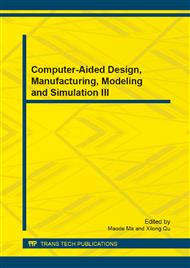p.169
p.174
p.180
p.184
p.189
p.194
p.201
p.205
p.209
Research on Stress Acoustic Model in the Process of Mechanical Self-Excited Vibration Based on Finite Element Method
Abstract:
The self-excited vibration of machinery is a common vibration in mechanical vibrations. Mechanical self-excited vibration destroys the normal working of the mechanical device and leads to mechanical fatigue damage. If the self-excited vibration reaches to the vibration frequency of machinery, it can produce the resonance and result in the scrapping of mechanical devices. The study of mechanical self-excited vibration has great significance. According to mathematical finite element methods, this paper establishes the mathematical model of the mechanical natural frequency through the finite volume method and gives the mathematical derivation formula of mechanical devices self-vibrated frequency. The second part of the paper simulates self-vibrated process of machinery using the professional software ANSYS software. First, it establishes a three-dimensional model of the mechanical device through the pre-processing module and analyzes mechanical self-excited vibration through calculation module and gets the frequency modal map of self-excited vibration process. It studies the mechanism of the mechanical self-excited vibration combining with modern signal analysis techniques--wavelet analysis. It gets the vibration source location which provides a reliable theoretical basis for the study of mechanical self-excited vibration.
Info:
Periodical:
Pages:
189-193
Citation:
Online since:
October 2013
Authors:
Price:
Сopyright:
© 2014 Trans Tech Publications Ltd. All Rights Reserved
Share:
Citation:


